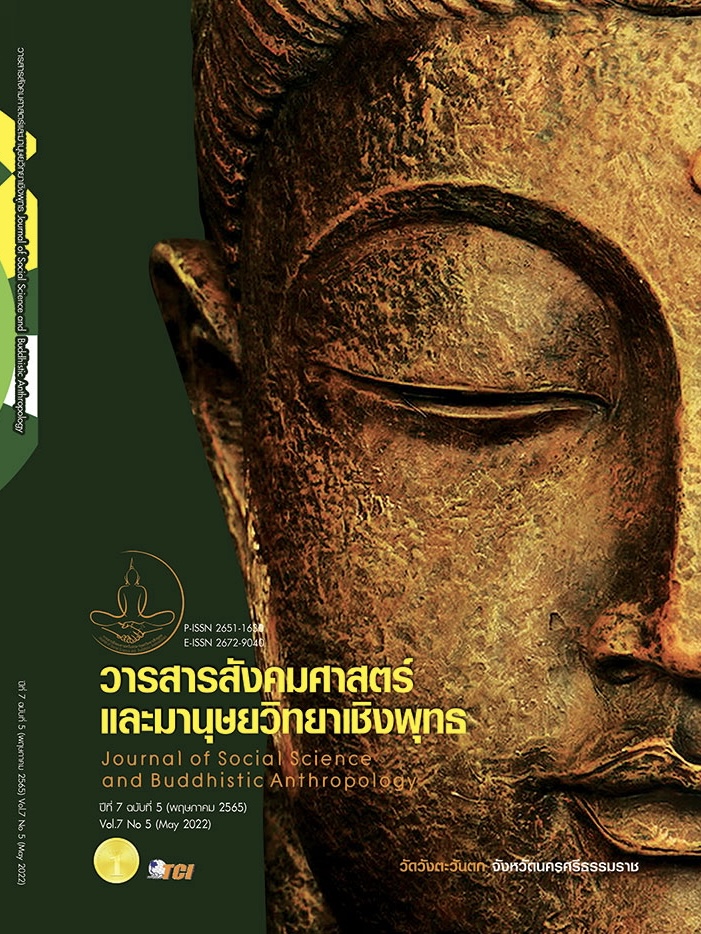THE CAUSAL RELATIONSHIP MODEL OF TEAMWORK BEHAVIOR OF PRIMARY STUDENTS AT ROI-ET PRIMARY EDUCATIONAL SERVICE AREA OFFICE 3
Keywords:
The Causal Relationship Model, Teamwork Behavior, Primary StudentsAbstract
This objective of this research article were to: 1) to study the causal relationship of emotional intelligence, work motivation, teacher social support, attitude towards teamwork behavior and self-efficacy of teamwork towards teamwork behavior of primary student at Roi-Et primary educational service area office 3. 2) study of the patterns of relationship between the factor effecting teamwork behavior of primary student. The sample of this quantitative research consisted of 350 students selected by using multi-stage random sampling. Questionnaires were used for data collection. The questionnaires had content validity in the range of 0.6 - 1.00 the validity values of 0.72 - 0.84. The statistics used for data analysis were path analysis. The results showed: 1) the causal relationship of emotional intelligence, work motivation, teacher social support, attitude towards teamwork behavior and self-efficacy of teamwork towards teamwork behavior of primary student at Roi-Et primary educational service area office 3. The modified causal model showed a good fit ( 2 = 199.25, df = 77, RMR = 0.51, CFI = 0.98, GFI = 0.93, NFI = 0.97, RMSEA = 0.067). 2) The causal model of teamwork towards teamwork behavior of primary student at Roi-Et primary educational service area office 3 was found to be emotional intelligence, work motivation, teacher social support, attitude towards teamwork behavior and self-efficacy of teamwork had a direct and indirect influence on teamwork behavior has a total influence of 0.37, 0.35, 0.03, 0.24 and 0.26 and all of this variables together can explains teamwork behavior of primary student at Roi-Et primary educational service area office 3 by 85 percent.
References
กรกนก บุญชูจรัส. (2552). ปัจจัยที่มีความสัมพันธ์ต่อการทำงานเป็นทีมของพัฒนากรในพื้นที่ความรับผิดชอบของศูนย์ศึกษาพัฒนาชุมชน จังหวัดเพชรบุรี. ใน วิทยานิพนธ์ศึกษาศาสตรมหาบัณฑิต สาขาวิชาการศึกษาตลอดชีวิตและการพัฒนามนุษย์. มหาวิทยาลัยศิลปากร.
กรมสุขภาพจิต. (2543). อีคิว: ความฉลาดทางอารมณ์. กรุงเทพมหานคร: สำนักพัฒนาสุขภาพจิต กรมสุขภาพจิต.
กระทรวงศึกษาธิการ. (2551). หลักสูตรแกนกลางการศึกษาขั้นพื้นฐานพุทธศักราช 2551. กรุงเทพมหานคร: ชุมนุมสหกรณ์การเกษตรแห่งประเทศไทย.
จิวีณา พีชะพัฒน์. (2554). ผลของการรับรู้ความสามารถของตนเองและการรับรู้การสนับสนุนทางสังคมต่อสุขภาวะในวัยรุ่นตอนต้น. เรียกใช้เมื่อ 21 ธันวาคม 2563 จาก https://smarterlifebypsychology.com/2019/09/30/social-support-การสนับสนุนทางสังคม/
ทิศนา แขมมณี. (2545). กลุ่มสัมพันธ์เพื่อการทำงานและการจัดการเรียนการสอน. กรุงเทพมหานคร: นิชินแอดเวอร์ไทซิ่งกรู๊ฟ.
ทิศนา แขมมณี. (2554). รูปแบบการเรียนการสอน:ทางเลือกที่หลากหลาย. (พิมพ์ครั้งที่ 7). กรุงเทพมหานคร: สำนักพิมพ์แห่งจุฬาลงกรณ์มหาวิทยาลัย.
ปลื้มจิตร บุญพึ่ง. (2559). ปัจจัยที่ส่งผลต่อพฤติกรรมการทำงานเป็นทีมของพนักงานสายปฏิบัติการวิชาชีพและบริหารทั่วไป มหาวิทยาลัยเทคโนโลยีสุรนารี. วารสารมนุษยศาสตร์และสังคมศาสตร์, 35(6), 135-147.
ปวีณา คําพุกกะ. (2553). โมเดลเชิงสาเหตุของประสิทธิผลของทีมของชมรมนิสิตนักศึกษาที่มีความฉลาดทางอารมณ์ของกลุ่มเป็นตัวแปรส่งผ่าน: การวิจัยเชิงศึกษาเปรียบเทียบ. ใน ดุษฎีนิพนธ์ครุศาสตรดุษฎีบัณฑิต สาขาวิธีวิทยาการวิจัยการศึกษา. จุฬาลงกรณ์มหาวิทยาลัย.
พิมพันธ์ เดชะคุป. (2558). การจัดการเรียนรู้ในศตวรรษที่ 21. (พิมพ์ครั้งที่ 2). กรุงเทพมหานคร: โรงพิมพ์แห่งจุฬาลงกรณ์มหาวิทยาลัย.
ไพฑูรย์ สินลารัตน์. (2557). เติบโตเต็มตามศักยภาพสู่ศตวรรษที่ 21 ของการศึกษาไทย. กรุงเทพมหานคร: วิทยาลัยครุศาสตร์ มหาวิทยาลัยธุรกิจบัณฑิตย์.
วันทนา วัฒนธรรม. (2557). ปัจจัยทางจิตลักษณะและสถานการณ์ที่เกี่ยวข้องกับพฤติกรรมการทำงานเป็นทีมมีประสิทธิภาพของพนักงานเครือเดอะมอลล์กรุ๊ป. ใน วิทยานิพนธ์วิทยาศาสตรมหาบัณฑิต สาขาการวิจัยพฤติกรรมศาสตร์ประยุกต์. มหาวิทยาลัยศรีนครินทรวิโรฒ.
ศันสนีย์ ชูเชื้อ. (2546). ปัจจัยที่ส่งผลต่อการทำงานเป็นทีมของพนักงานมหาวิทยาลัยวลัยลักษณ์. ใน วิทยานิพนธ์บริหารธุรกิจมหาบัณฑิต สาขาการจัดการ. มหาวิทยาลัยวลัยลักษณ์.
สำนักงานเขตพื้นที่การศึกษาประถมศึกษาร้อยเอ็ด เขต 3. (2562). รายงานผลการดำเนินงานปีงบประมาณ 2562. ร้อยเอ็ด: สำนักงานเขตพื้นที่การศึกษาประถมศึกษาร้อยเอ็ด เขต 3.
สำนักงานเขตพื้นที่การศึกษาประถมศึกษาร้อยเอ็ด เขต 3. (2563). จำนวนโรงเรียนในสังกัด ปีการศึกษา 2563. เรียกใช้เมื่อ 21 มิถุนายน 2563 จาก http://www.roiet3. go.th/index.php/
สำนักงานเขตพื้นที่การศึกษาประถมศึกษาร้อยเอ็ด เขต 3. (2564). แผนพัฒนาการศึกษาขั้นพื้นฐาน ระยะ 5 ปี พ.ศ. 2561 - 2564. ร้อยเอ็ด: สำนักงานเขตพื้นที่การศึกษาประถมศึกษาร้อยเอ็ด เขต 3.
สำนักงานเลขาธิการสภาการศึกษา. (2559). แผนการศึกษาชาติ พ.ศ. 2560 - 2574. กรุงเทพมหานคร: พริกหวานกราฟฟิค.
สุเทพ เหลาแตว. (2556). ปัจจัยที่ส่งผลต่อการทำงานเป็นทีมตามความคิดเห็นของครูสังกัดสำนักงานเขตพื้นที่การศึกษาประถมศึกษานครราชสีมาเขต 4. ใน วิทยานิพนธ์การศึกษามหาบัณฑิต สาขาการบริหารการศึกษา. มหาวิทยาลัยมหาสารคาม.
สุวิมล ติรกานันท์. (2550). การสร้างเครื่องมือวัดตัวแปรในการวิจัยทางสังคมศาสตร์: แนวทางสู่การปฏิบัติ. กรุงเทพมหานคร: โรงพิมพ์แห่งจุฬาลงกรณ์มหาวิทยาลัย.
อนุชา แก้วหลวง. (2545). ปัจจัยที่มีผลต่อประสิทธิภาพการทำงานเป็นทีมของอาจารย์ สถาบันเทคโนโลยีราชมงคล วิทยาเขตภาคพายัพ (เจ็ดยอด). กรุงเทพมหานคร: สถาบันเทคโนโลยีราชมงคล วิทยาเขตภาคพายัพ.
อังศินันท์ อินทรกำแหง และวรสรณ์ เนตรทิพย์. (2555). รูปแบบความสัมพันธ์เชิงสาเหตุด้านบุคคลและสภาพแวดล้อมในงานที่มีต่อพฤติกรรมบริการงานสร้างเสริมสุขภาพและป้องกันโรคของบุคลากรทางการแพทย์. วารสารพฤติกรรมศาสตร์, 18(1), 34-48.
Bandura, A. (1997). Self-Efficacy: The Exercise of Control. New York: W.H. Freeman and Company.
Bandura, A. (2000). Self-efficacy: The foundation of agency. New York: Lawrence Erlbaum Associates Publishers.
Cobb, S. (1976). Social support as a moderator of life stress. Psychosomatic Medicine, 38(1), 300-311.
Dawkins, S. l. (2014). New directions in Psychological Capital research: A critical analysis and theoretical and empirical extensions to individual- and team-level measurement. Australia: The Tasmanian School of Business & Economics University of Tasmania.
Diamantopouos, A. & Siguaw, A. D. (2000). Introduction LISREL: A guide for the uninitiated. London: Sage Publication.
Eriken, E. H. (1993). Childhood and Society. New York: Norton.
Fiechtner, S. B. & Davis, E. A. (2016). Republication of “Why some groups fail: A survey of students’ experiences with learning groups”. Journal of Management Education, 40(1), 12-29.
Goleman, D. (1998). Working with emotional intelligence. New York: Bantam Books.
Havighurst, R. J. (1972). Developmental tasks and education. (3rd ed.). New York: McKay.
Joreskog, K. & Sorbom, D. (1993). LISREL 8: Structural Equation Modelling with the SIMPLIS Command Language. Chicago: Scientific Software International Inc.
Kelloway, E. K. (1998). Using LISREL for structural equation modeling: A researcher's guide. New York: Sage Publications.
Kline, R. B. (1998). Principles and Practice of Structural Equation Modeling. New York: The Guilford Press.
Lin, N. (1979). Social support, stressful life events, and illness: A model and an empirical test. Journal of Health and Social Behavior, 20(1), 108-118.
McGuire, W. J. (1985). Attitudes and Attitude Change. ใน Lindzey, G. & Aronson, E. (Eds.). Handbook of Social Psychology. (3rd ed.). New York: Random House.
Tasa, K. et al. (2007). The development of collective efficacy in teams: a multilevel and longitudinal perspective. Journal of applied psychology, 92(1), 7-27.
Taylor, S. E. (2011). Social support: A review. The Handbook of Health Psychology. New York: Oxford University Press.
Ted, B. et al. (2017). Emotional intelligence and personality traits as predictors of undergraduate occupational therapy students’ teamwork skills: A cross-sectional study. British Journal of Occupational Therapy, 80(7), 432-439.
Woodcock, M. & Francis, D. (1994). Teambuilding Strategy. (2nd ed). Cambridge: Cambridge University Press.
Downloads
Published
How to Cite
Issue
Section
License
Copyright (c) 2022 Journal of Social Science and Buddhistic Anthropology

This work is licensed under a Creative Commons Attribution-NonCommercial-NoDerivatives 4.0 International License.








